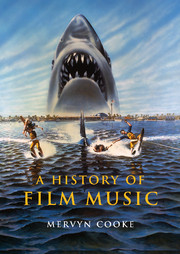Book contents
- Frontmatter
- Contents
- List of illustrations
- Preface and acknowledgements
- 1 The ‘silent’ cinema
- 2 Sound on track
- 3 Hollywood's Golden Age: narrative cinema and the classical film score
- 4 Stage and screen
- 5 The mainstream divides: post-war horizons in Hollywood
- 6 ‘Never let it be mediocre’: film music in the United Kingdom
- 7 Defectors to television
- 8 Film music in France
- 9 Global highlights
- 10 Popular music in the cinema
- 11 Classical music in the cinema
- 12 State of the art: film music since the New Hollywood
- Bibliography
- Index of film titles
- General index
1 - The ‘silent’ cinema
Published online by Cambridge University Press: 05 February 2015
- Frontmatter
- Contents
- List of illustrations
- Preface and acknowledgements
- 1 The ‘silent’ cinema
- 2 Sound on track
- 3 Hollywood's Golden Age: narrative cinema and the classical film score
- 4 Stage and screen
- 5 The mainstream divides: post-war horizons in Hollywood
- 6 ‘Never let it be mediocre’: film music in the United Kingdom
- 7 Defectors to television
- 8 Film music in France
- 9 Global highlights
- 10 Popular music in the cinema
- 11 Classical music in the cinema
- 12 State of the art: film music since the New Hollywood
- Bibliography
- Index of film titles
- General index
Summary
As has often been remarked, the cinema has never been silent: the so-called silent films which represented the first flowering of the medium from the 1890s to the late 1920s often used sound as a vital part of the filmic experience. Accompanying music was only one of a diverse range of sonic options available to exhibitors in the early years of cinema; yet the familiarity of the fairly elaborate musical provision characterizing the later years of silent film (c.1914–27) has tended to result in the assumption that music was both constantly used and deemed aesthetically viable well before this period. As Rick Altman has argued, however, during the early development of the moving picture (c.1895–c.1913) it was not uncommon for films to be projected with no organized sound component at all (Altman 2004, 193–201). Yet, by the start of the 1920s, film-music pioneer George Beynon could declare without fear of contradiction: ‘Allowing the picture to be screened in silence is an unforgivable offense that calls for the severest censure. No picture should begin in silence under any conditions’ (Beynon 1921, 76).
Why sound?
Altman's careful research established that ‘silent films were in fact sometimes silent, … and what's more it did not appear to bother audiences a bit’ (Altman 1996, 649); but audience noise and direct audience participation were more prominent at the turn of the twentieth century than they are in today's cinema in the West, so to this extent films were never truly experienced in silence.
- Type
- Chapter
- Information
- A History of Film Music , pp. 1 - 41Publisher: Cambridge University PressPrint publication year: 2008



